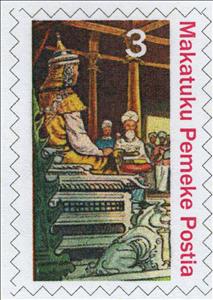Stamp: Dam Batai State of Makatuku Pemeke: Sultan meets King (Fantasy Issues 2016)
Dam Batai State of Makatuku Pemeke: Sultan meets King (Fantasy Issues 2016)
01 January (Fantasy Issues ) within release Dam Batai goes into circulation Stamp Dam Batai State of Makatuku Pemeke: Sultan meets King face value 3 Unit
| Stamp Dam Batai State of Makatuku Pemeke: Sultan meets King in catalogues | |
|---|---|
| Colnect codes: | Col: MM-DB 2016-31 |
Stamp is vertical format.
Design size: 30 x 40 mm Issue originated in 1976 with Burmese themes and values shown is of a Bogus Currency, with no postal value within the then BurmaAlso in the issue Dam Batai:
- Stamp - Dan Batai - Graate - Butterfly face value 35;
- Stamp - Dam Batai - Province: De Gap - Burmese Water Bearers face value 5;
- Stamp - Dam Batai - Province: ILIS Day - Tzifdui Gruipyong face value 7;
- Stamp - Dam Batai - Province: Indrinia Water Birds 3 face value 5;
- Stamp - Dam Batai - Province: Zvuts Medal of Honour face value 8;
- Stamp - Dam Batai Interval Boat Service value: 50 face value 10;
- Stamp - Dam Batai Poste de Goguelus Province - Burmese Tapestry face value 10;
- Stamp - Dam Batai Province: Ahu'a Ægimôt - sailing ship face value 10;
- Stamp - Dam Batai Province: Atoy - Statue of General face value 1;
- Stamp - Dam Batai Province: Birurza River - Postage Due face value 10;
- Stamp - Dam Batai Province: Cedi Alofa DG with Dead Village Tree face value 3;
- Stamp - Dam Batai Province: De Gap - Burmese Hut on River face value 10;
- Stamp - Dam Batai Province: Hat Inca Football Game face value 15;
- Stamp - Dam Batai Province: Hat Inca Horse Jockey drinking tea face value 1;
- Stamp - Dam Batai Province: ILIS Day - Burmese Meeting Hall face value 10;
- Stamp - Dam Batai Province: Makatuku Pemeke Burmese woman AI Am Er face value 3;
- Stamp - Dam Batai Province: Matouche - Flower face value 4;
- Stamp - Dam Batai Province: Sdadagimoleg - Musicians value 3 face value 3;
- Stamp - Dam Batai Province: Stradal-Omsk face value 5;
- Stamp - Dam Batai Province: Stradal-Omsk face value 10;
- Stamp - Dam Batai Province: Stradal-Omsk face value 5;
- Stamp - Dam Batai Province: Tiopulu DG Horses in battle face value 3;
- Stamp - Dam Batai Province: Zvuts Burma Medal of Honour face value 7;
- Stamp - Dam Batai Province: Zvuts Burma Royal Air Force Squadron face value 2;
- Stamp - Dam Batai State - Makatuku Pemeke - Sultan face value 3;
- Stamp - Dam Batai State of Makatuku Pemeke: Sultan meets King face value 3;
- Stamp - Dan Batai Province: ILIS Day - Sand Pit face value 5;
- Stamp - DB Dependency of Atio - Boju Ofu, Burmese Jungle House face value 15;
- Stamp - DB Dependency of Atio - Boju Ofu, Burmese Jungle River face value 7;
- Stamp - DB Province: Arin og Telem Niss - Cana Crab face value 5;
- Stamp - DB Province: Arin og Telem Niss - Indrinia Palm face value 5;
- Stamp - DB Province: Boju OFU - Burmese Temple value 3 face value 3;
- Stamp - DB state: Makatuku Pemeke - Lyrebird face value 5;
Stamp Dam Batai State of Makatuku Pemeke: Sultan meets King it reflects the thematic directions:
In British heraldry, a coronet is any crown whose bearer is less than sovereign or royal in rank, irrespective of the crown's appearance. In other languages, this distinction is not made, and usually the same word for crown is used irrespective of rank (German: Krone, Dutch: Kroon, Swedish: Krona, French: Couronne, etc.) In this use, the English coronet is a purely technical term for all heraldic images of crowns not used by a sovereign, and implies nothing about the actual shape of the crown depicted. A Coronet is another type of crown, but is reserved for the lower ranks of nobility like Marquesses and Marchionesses, Earls and Countesses, Barons and Baronesses, and some Lords and Ladies. The specific design and attributes of the crown or coronet signifies the hierarchy and ranking of its owner.
Headgear may be worn for protection against cold (such as the Canadian tuque), heat, rain and other precipitation, glare, sunburn, sunstroke, dust, contaminants, etc. Helmets are worn for protection in battle or against impact, for instance when riding bicycles or motor vehicles. There are also hats that are worn for protection from the cold
King is the title given to a male monarch in a variety of contexts. The female equivalent is queen regnant (while the title of queen on its own usually refers to the consort of a king). In the context of prehistory, antiquity and contemporary indigenous peoples, the title may refer to tribal kingship. Germanic kingship is cognate with Indo-European traditions of tribal rulership (c.f. Indic rājan, Gothic reiks, and Old Irish rí, etc.) In the context of classical antiquity, king may translate Latin rex or either Greek archon or basileus. In classical European feudalism, the title of king as the ruler of a kingdom is understood as the highest rank in the feudal order, potentially subject, at least nominally, only to an emperor (harking back to the client kings of the Roman Empire). In a modern context, the title may refer to the ruler of one of a number of modern monarchies (either absolute or constitutional). The title of king is used alongside other titles for monarchs, in the West prince, emperor, archduke, duke or grand duke, in the Middle East sultan or emir; etc. Kings, like other royalty, tend to wear purple because purple was an expensive color to wear in the past.
A gift or a present is an item given to someone, without the expectation of payment or anything in return. An item is not a gift if that item is already owned by the one to whom it is given. Although gift-giving might involve an expectation of reciprocity, a gift is meant to be free. In many countries, the act of mutually exchanging money, goods, etc. may sustain social relationship and contribute to social cohesion. Economists have elaborated the economics of gift-giving into the notion of a gift economy. By extension, the term gift can refer to any item or act of service that makes the other happier or less sad, especially as a favour, including forgiveness and kindness. Gifts are often presented on occasions such as birthdays and holidays.
Sultan is a title of Arabic origin for Islamic rulers who are monarchs. The title often corresponds to that of a king.





